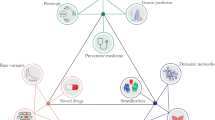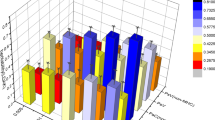Abstract
We carried out a meta-analysis of two recent psoriasis genome-wide association studies1,2 with a combined discovery sample of 1,831 affected individuals (cases) and 2,546 controls. One hundred and two loci selected based on P value rankings were followed up in a three-stage replication study including 4,064 cases and 4,685 controls from Michigan, Toronto, Newfoundland and Germany. In the combined meta-analysis, we identified three new susceptibility loci, including one at NOS2 (rs4795067, combined P = 4 × 10−11), one at FBXL19 (rs10782001, combined P = 9 × 10−10) and one near PSMA6-NFKBIA (rs12586317, combined P = 2 × 10−8). All three loci were also associated with psoriatic arthritis (rs4795067, combined P = 1 × 10−5; rs10782001, combined P = 4 × 10−8; and rs12586317, combined P = 6 × 10−5) and purely cutaneous psoriasis (rs4795067, combined P = 1 × 10−8; rs10782001, combined P = 2 × 10−6; and rs12586317, combined P = 1 × 10−6). We also replicated a recently identified3 association signal near RNF114 (rs495337, combined P = 2 × 10−7).
This is a preview of subscription content, access via your institution
Access options
Subscribe to this journal
Receive 12 print issues and online access
$209.00 per year
only $17.42 per issue
Buy this article
- Purchase on Springer Link
- Instant access to full article PDF
Prices may be subject to local taxes which are calculated during checkout


Similar content being viewed by others
References
Nair, R.P. et al. Genome-wide scan reveals association of psoriasis with IL-23 and NF-kappaB pathways. Nat. Genet. 41, 199–204 (2009).
Ellinghaus, E. et al. Genome-wide association study reveals association of psoriasis with TRAF3IP2. Nat. Genet. (in the press) (2010).
Capon, F. et al. Identification of ZNF313/RNF114 as a novel psoriasis susceptibility gene. Hum. Mol. Genet. 17, 1938–1945 (2008).
Nestle, F.O., Di Meglio, P., Qin, J.Z. & Nickoloff, B.J. Skin immune sentinels in health and disease. Nat. Rev. Immunol. 9, 679–691 (2009).
Gladman, D.D. Psoriatic arthritis. in Moderate to Severe Psoriasis (eds. Koo, J., Lee, C.S., Lebwohl, M., Weinstein, G.D. & Gottlieb, A.B.) 239–258 (Informa Health Care, New York, 2009).
Gelfand, J.M. et al. Risk of myocardial infarction in patients with psoriasis. J. Am. Med. Assoc. 296, 1735–1741 (2006).
Makredes, M., Robinson, D. Jr., Bala, M. & Kimball, A.B. The burden of autoimmune disease: a comparison of prevalence ratios in patients with psoriatic arthritis and psoriasis. J. Am. Acad. Dermatol. 61, 405–410 (2009).
Russell, T.J., Schultes, L.M. & Kuban, D.J. Histocompatibility (HL-A) antigens associated with psoriasis. N. Engl. J. Med. 287, 738–740 (1972).
Tiilikainen, A., Lassus, A., Karvonen, J., Vartiainen, P. & Julin, M. Psoriasis and HLA-Cw6. Br. J. Dermatol. 102, 179–184 (1980).
Nair, R.P. et al. Sequence and haplotype analysis supports HLA-C as the psoriasis susceptibility 1 gene. Am. J. Hum. Genet. 78, 827–851 (2006).
Hollox, E.J. et al. Psoriasis is associated with increased beta-defensin genomic copy number. Nat. Genet. 40, 23–25 (2008).
Elder, J.T. et al. Molecular dissection of psoriasis: integrating genetics and biology. J. Invest. Dermatol. 130, 1213–1236 (2009).
Li, Y., Willer, C., Sanna, S. & Abecasis, G. Genotype imputation. Annu. Rev. Genomics Hum. Genet. 10, 387–406 (2009).
Chandran, V., Schentag, C.T. & Gladman, D.D. Sensitivity and specificity of the CASPAR criteria for psoriatic arthritis in a family medicine clinic setting. J. Rheumatol. 35, 2069–2070, author reply 2070 (2008).
Zaba, L.C., Krueger, J.G. & Lowes, M.A. Resident and “inflammatory” dendritic cells in human skin. J. Invest. Dermatol. 129, 302–308 (2009).
Melchiorri, C. et al. Enhanced and coordinated in vivo expression of inflammatory cytokines and nitric oxide synthase by chondrocytes from patients with osteoarthritis. Arthritis Rheum. 41, 2165–2174 (1998).
Cal, S. et al. Identification and characterization of human polyserase-3, a novel protein with tandem serine-protease domains in the same polypeptide chain. BMC Biochem. 7, 9 (2006).
Lu, T. et al. Regulation of NF-kappaB by NSD1/FBXL11-dependent reversible lysine methylation of p65. Proc. Natl. Acad. Sci. USA 107, 46–51 (2010).
Jin, J. et al. Systematic analysis and nomenclature of mammalian F-box proteins. Genes Dev. 18, 2573–2580 (2004).
Chung, J.S., Bonkobara, M., Tomihari, M., Cruz, P.D. Jr. & Ariizumi, K. The DC-HIL/syndecan-4 pathway inhibits human allogeneic T-cell responses. Eur. J. Immunol. 39, 965–974 (2009).
Todd, J.A. et al. Robust associations of four new chromosome regions from genome-wide analyses of type 1 diabetes. Nat. Genet. 39, 857–864 (2007).
Schadt, E.E. et al. Mapping the genetic architecture of gene expression in human liver. PLoS Biol. 6, e107 (2008).
Scott, L.J. et al. A genome-wide association study of type 2 diabetes in Finns detects multiple susceptibility variants. Science 316, 1341–1345 (2007).
Frazer, K.A. et al. A second generation human haplotype map of over 3.1 million SNPs. Nature 449, 851–861 (2007).
Huang, L. et al. Genotype-imputation accuracy across worldwide human populations. Am. J. Hum. Genet. 84, 235–250 (2009).
de Bakker, P.I. et al. Practical aspects of imputation-driven meta-analysis of genome-wide association studies. Hum. Mol. Genet. 17, R122–R128 (2008).
Devlin, B., Roeder, K. & Wasserman, L. Genomic control, a new approach to genetic-based association studies. Theor. Popul. Biol. 60, 155–166 (2001).
Horton, R. et al. Gene map of the extended human MHC. Nat. Rev. Genet. 5, 889–899 (2004).
de Cid, R. et al. Deletion of the late cornified envelope LCE3B and LCE3C genes as a susceptibility factor for psoriasis. Nat. Genet. 41, 211–215 (2009).
Abu Bakar, S., Hollox, E.J. & Armour, J.A. Allelic recombination between distinct genomic locations generates copy number diversity in human beta-defensins. Proc. Natl. Acad. Sci. USA 106, 853–858 (2009).
Gudjonsson, J.E. et al. Global gene expression analysis reveals evidence for decreased lipid biosynthesis and increased innate immunity in uninvolved psoriatic skin. J. Invest. Dermatol. 129, 2795–2804 (2009).
Acknowledgements
The authors wish to thank the many psoriasis and PsA cases and normal controls who participated in this study and to acknowledge the key contributions of K. Callis Duffin, D. Goldgar and B. Jian Feng of the University of Utah and C. Helms of Washington University at St. Louis to the CASP study. This research was supported by grants R01AR42742, R01AR050511, R01AR054966, R01AR050266, R01HG002651 and U01HG005214 from the US National Institutes of Health, by the Ann Arbor Veterans Affairs Hospital, by the German Ministry of Education and Research through the National Genome Research Network (BMFT 01GS 0171/ BMBF NUW-S23T10) and by the Krembil Foundation and the Canadian Institutes of Health Research.
Author information
Authors and Affiliations
Contributions
R.P.N., P.E.S. and J.T.E. performed SNP selection, data analysis and prepared the figures and tables. R.P.N., T.T., P.E.S., P.R. and E.E. performed genotyping. P.E.S., Y.L. and J.D. performed genotype imputation and association analyses, and P.E.S., J.E.G., and J.D. performed the expression analyses. G.R.A. helped with statistical analyses and interpretation of results. R.P.N., T.T., J.J.V., R.I., M.W., S.W., B.E., C.G., H.E.W., H.W.L., P.R., M.K., U.M. and D.D.G. coordinated subject recruitment and collected phenotype data. J.T.E., G.G.K. and A.M.B. contributed genotypes and phenotypes from the CASP discovery GWAS. J.T.E. and P.E.S. drafted the manuscript; R.P.N., G.R.A., E.E., M.W. and A.F. edited the manuscript; and J.T.E. planned and supervised the study. All authors approved the final draft.
Corresponding author
Ethics declarations
Competing interests
The authors declare no competing financial interests.
Supplementary information
Supplementary Text and Figures
Supplementary Tables 1–6 and Supplementary Figures 1 and 2. (PDF 2747 kb)
Rights and permissions
About this article
Cite this article
Stuart, P., Nair, R., Ellinghaus, E. et al. Genome-wide association analysis identifies three psoriasis susceptibility loci. Nat Genet 42, 1000–1004 (2010). https://doi.org/10.1038/ng.693
Received:
Accepted:
Published:
Issue Date:
DOI: https://doi.org/10.1038/ng.693
This article is cited by
-
Association of intronic polymorphisms (rs1549339, rs13402242) and mRNA expression variations in PSMD1 gene in arsenic-exposed workers
Environmental Science and Pollution Research (2020)
-
Risk of Psoriasis Following Terbinafine or Itraconazole Treatment for Onychomycosis: A Population-Based Case-Control Comparative Study
Drug Safety (2018)
-
Psoriasis in Skin of Color: Insights into the Epidemiology, Clinical Presentation, Genetics, Quality-of-Life Impact, and Treatment of Psoriasis in Non-White Racial/Ethnic Groups
American Journal of Clinical Dermatology (2018)
-
Genome-wide association and targeted analysis of copy number variants with psoriatic arthritis in German patients
BMC Medical Genetics (2017)
-
Association of IL12B risk haplotype and lack of interaction with HLA-Cw6 among the psoriasis patients in India
Journal of Human Genetics (2017)



